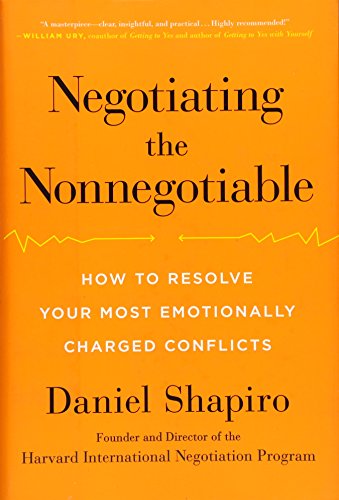Today, I would like to talk about one of the most interesting and useful books that I read last year. “Negotiating the Nonnegotiable” by Daniel Shapiro which was an excellent read and helped me rethink some of my own beliefs and habits in talking/negotiating/dealing with my customers, partners, and employees.

I first get interested in “Negotiation” when Azadeh Momeni, was actively involved in translating a great book on negotiation into my native language, Farsi. The book was called “The First Move. A Negotiator’s Companion” by Alain Lempereur and Aurélien Colson. I remember I enjoyed reading this book in English and Persian at the same time. Since then, negotiation and negotiating has been a very interesting and challenging topic for me. Negotiation might not look very pleasant, but it is an important part of our daily life.
- As soon as we wake up, we start negotiating with ourselves. What shirt should I wear?
- How should I respond to this angry client?
- What should I say to my client who is not paying his/her invoices on time?
- How should I ask my boss for a raise?
- How should I discuss this fantastic business opportunity with the other party?
Some of these situations are pretty routine, and straightforward. You want a raise, you go to your boss, explain why you deserve this, and you try working out something. However, there are situations where we are involved in emotionally charged conflicts. This could be quite challenging for parties involved in the negotiation process. The book by Shapiro is a great read for people who are trying to do a better job in these situations.
We are Human !
As Shapiro puts it, people in conflict are, and always will be, Human. negotiation is a human thing. People involved in conflicts come with their emotions, own reasoning, and their particular way of looking into matters. Being human means being different, and having different values: for some, money will be more important, while for others, Pride can be the bargain. Some will look into negotiating with the other party as Win or Die type of game, while others try to work out something meaningful for everyone. The questions is, how parties can bridge the gap between their fundamental values?!
Emotions
Emotions play a huge role in our daily life. We love, we laugh, we cheer, we fight, and we cry. Most of our daily actions are filled with emotions. The color of our purse should match our shoes. We get nervous when our city’s Hockey team loses in the final match. Emotions can unite people, and can drive them to conflict. Emotions, as Shapiro puts it, can tear apart the closest friendships, or destroy a business. In order to avoid repeatedly engaging in conflicts, we must learn the counteract of the forces that derive us to conflict.
Third Dimension: Identity
Three dimensions of conflict resolutions can be described as the following:
1) Homo economicus: which regards people as rational actors. In this model, people often look into maximizing the mutual gain, or at least satisfying own interest without worsening those of other parties.
2) Homo emoticus: In this model, it is believed that emotions animate our actions and thoughts. Emotions can be helpful in conflict resolution if we start listening to what they are telling us. But at the same time, emotions can worsen the situation in conflict resolutions.
3) Homo identicus: The realm of identity shapes the third dimension of human behavior. This is where human beings seek meaning in their existence. Most often, an emotionally charged conflict gets its charge, because it involves fundamental aspects of our identity, like who we are, what we value.
Why Should You Consider Reading This
The book offers excellent practical solutions to tackle our toughest disputes – those that threaten our identity. The conflict resolution scenarios described in this book can help readers to solve their conflicts more effectively, and foster reconciliation in their personal and professional life.
If you are involved in an emotionally charged conflict with your partner, customers, competitors, this book helps you with some practical advice on how to improve matters.
